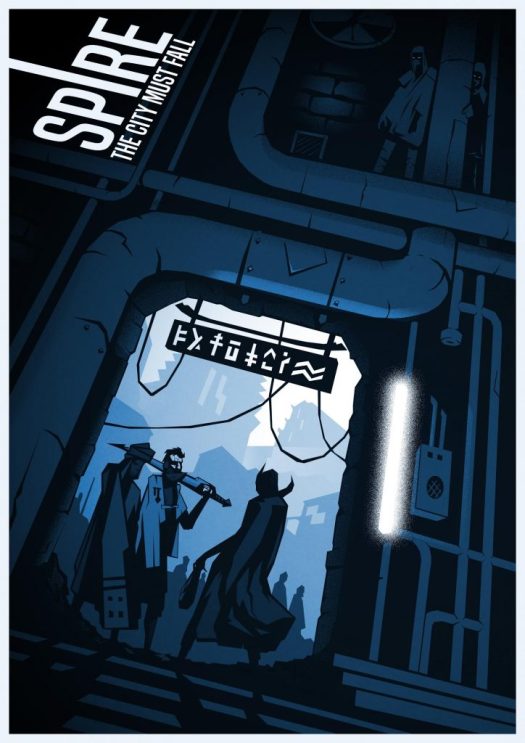I’m on a study project to improve my understanding of roleplaying games. To this end, I already have two reading projects, A Game Per Year and An Adventure Per Year. This is the third, with the goal of reading or playing 52 games made this year or last year. Originally I considered making this “A New RPG Per Week” and that’s where the number 52 comes from, even though a weekly schedule is probably not within my abilities.

Spire is a roleplaying game about dark elves who fight for their freedom against high elf conquerors. The titular Spire is an impossible city built into a vast, mysterious monolith. Originally inhabited by the drow, it has been taken over by the aelfir who have installed themselves as a colonial ruling class.
The player characters belong to an insurgent organization called the Ministry and seek to overthrow the aelfir, as well as more tangible, everyday enemies of the people.
Spire is an interesting game because it’s very hard to see it outside of the context of roleplaying game discourse. The drow, popularized in Dungeons & Dragons and other games, have long been extremely popular but also subject to a lot of critical debate.
Traditionally, in D&D the drow are a matriarchal subterranean people of evil black-skinned, white haired elves who worship a spider goddess called Lolth. Depictions of the drow have often featured BDSM imagery and themes.
The critical discussion has revolved around questions of race and sex. What does it mean to make the black-skinned elves into evil degenerates? In larp, this has the additional embarrassment of white players playing drow in blackface.
(In recent years, game publishers have tried to sidestep the image of evil black elves by making them grey, white or even bluish or purple.)
The connection between the drow and sex goes back to the idea of a matriarchal society ruled by evil whip-wielding priestesses subjugating hot, androgynous men while dressed in leather outfits. Indeed, in the field of roleplaying game culture, the drow as traditionally depicted are probably the greatest bastion of kink representation.
So if the drow are all this, what does Spire do with them?
The drow are the underdogs. They are the people, oppressed by pale colonizers from the north. The drow is the normal, baseline character of the game and the aelfir are depicted as alien and strange.
The aelfir are cruel and incapable of grasping the full range of emotion. This is why they don’t have moral qualms about killing the drow, but in a neat trick of setting design it also makes it seem less evil to kill them in return.
One of the great strengths of Spire is in the nuance of the setting. It’s clearly been built with an understanding of systemic privilege. Individual aelfir may be destitute and individual drow can grow rich but that doesn’t mean that the system isn’t stacked heavily in favor of the colonizers.
Indeed, the richness of the setting can be exhausting. In terms of style the game is modern post-steampunk, comparable to videogames like Dishonored and Fallen London. Social ills in the mode of Charles Dickens are strongly present and magic and technology exist side by side.
Much of the gamebook consists of an exploration of Spire as a setting and the sheer wealth of ideas and details is immense, enough for a multitude of roleplaying game campaigns.
The drow of Spire have been thoroughly desexualized, both in the visuals and in how the setting is described. The whip-wielding kink goddesses and submissive pretty boys of past drow depictions are nowhere to be seen. Indeed, visually the game is very tasteful.
The game mechanics continue the association with roleplaying game discourse that pervades the book. There’s even a nod towards my particular scene, a safety method called “lines and veils” ascribed to “Nordic LARP”. The idea is that a player can draw a line, meaning something they don’t want to be featured in the game at all, or a veil, meaning something that can exist in the game but shouldn’t be played out in detail.
For example, the book says that when the authors run a game, sex is behind a veil, meaning that it can be present in the fiction but won’t be played out.
(My understanding is that the “lines and veils” method was actually detailed by the storygames guru Ron Edwards.)
Spire is one of the most interesting roleplaying games I’ve read recently. It has a vast panoply of ideas, reminding me of how it felt to read Planescape for the first time as a kid. The basic setup of an anti-colonial drow struggle is very appealing and the setting is chock full of play opportunities.
If I wanted to point out to a particular piece of design genius, that would be the character classes. They manage to be both appealing, usable and original, efficiently melding the unique and the universal. An example is the fighter type Knight of the North Docks, a boozy armored barfly.